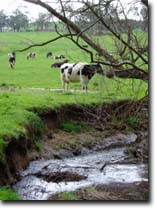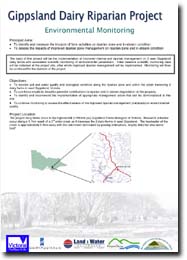Module 6: Riparian Zone Management: Reducing water quality impacts from dairy cows
Productive Grazing, Healthy Rivers - Home
| Background Dairy farm management practices, including nutrient and stock management, can have negative consequences for riparian zones and water quality. Nutrients such as nitrogen (N), phosphorus (P), and potassium (K) are returned in dung and urine, often in considerably greater rates than average fertiliser applications. Inappropriate stock management leading to stock camps, night paddocks and losses of dung and urine can result in increased nutrient and microbial levels in waterways and riparian zones. Excessive fertiliser use or its direct application to riparian zones and waterways can likewise contribute to degradation of these areas. Management and siting of effluent ponds, dairy sheds and tracks can also result in reduced water quality and riparian zone condition. In addition, stock access to riparian areas fouls water contributing to increased sedimentation, bank erosion, and loss of vegetation through trampling and consumption. |  |
Identification and development of appropriate riparian zone best management practices (BMPs) depends on understanding the impact of farm management activities such as these on riparian areas. Aim This project based on commercial dairy farms in West Gippsland aims to monitor farm management impacts on the riparian zone and water quality. Riparian zone BMPs to reduce the impact of dairy cows on water quality will also be identified. | |
A research site has been established in West Gippsland, where soil and water nutrients (N,P,K), sediment and microbial levels, water temp, pH, rainfall, water flow and biodiversity (mammals/birds/frogs/in-stream macroinvertebrates) are monitored regularly. Information about the farm management activities along the research site is also recorded. In addition to improving our knowledge about the farm management impacts on the riparian zone and water quality, this site will act as a valuable demonstration site and educational tool for Landcare and other natural resource management agencies.
Contact
Dr Sharon Aarons
Ph: (03) 5624 2222
Email: Sharon.Aarons@dpi.vic.gov.au
| Module 1: What lives along your stream? Quantifying on-farm riparian biodiversity Productive Grazing, Healthy Rivers - Improving riparian and in-stream biodiversity - Project Report 2006 - Module 1 - Quantifying on-farm riparian biodiversity (PDF 289KB). To view the information PDF requires the use of a PDF reader. This can be installed for free from the Adobe website (external link). Module 2: Wood to Water: habitat creation within restored and replanted riparian land Productive Grazing, Healthy Rivers - Improving riparian and in-stream biodiversity - Project Report 2006 - Module 2 Wood to Water: Habitat creation within replanted riparian land (PDF 142KB). To view the information PDF requires the use of a PDF reader. This can be installed for free from the Adobe website (external link). |
Productive Grazing, Healthy Rivers - Improving riparian and in-stream biodiversity - Project Report 2006 - Module 3 - Regeneration in remnant vegetation: Overcoming the barriers (PDF145KB). To view the information PDF requires the use of a PDF reader. This can be installed for free from the Adobe website (external link).
Module 4: Expert weed system: a support tool for on-farm management
Productive Grazing, Healthy Rivers - Improving riparian and in-stream biodiversity - Project Report 2006 - Module 4 - Riparian weed management system: Development of on-farm management tool (PDF 70KB). To view the information PDF requires the use of a PDF reader. This can be installed for free from the Adobe website (external link).
Module 5: Riparian condition and land-use practices: a survey of riparian health on dairy farms
Productive Grazing, Healthy Rivers - Improving riparian and in-stream biodiversity - Project Report 2006 - Module 5 - Riparian condition and land-use practices: A survey of riparian health & condition on dairy farms (PDF 127KB). To view the information PDF requires the use of a PDF reader. This can be installed for free from the Adobe website (external link).
Module 6: Riparian zone management: reducing water quality impacts from dairy cows
Productive Grazing, Healthy Rivers - Improving riparian and in-stream biodiversity - Project Report 2006 - Module 6 - Riparian zone management: Reducing water quality impacts on dairy cows (PDF 304KB). To view the information PDF requires the use of a PDF reader. This can be installed for free from the Adobe website (external link).



